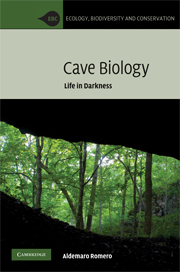Book contents
- Frontmatter
- Contents
- Preface
- Acknowledgments
- 1 A brief history of cave biology
- 2 Cave biodiversity
- 3 The evolutionary biology of cave organisms
- 4 The ecology of cave organisms
- 5 Cave conservation and management
- 6 Epilogue
- Appendix 1 Glossary of terms frequently used in biospeleology
- References
- Index
- Plate section
6 - Epilogue
Published online by Cambridge University Press: 21 October 2009
- Frontmatter
- Contents
- Preface
- Acknowledgments
- 1 A brief history of cave biology
- 2 Cave biodiversity
- 3 The evolutionary biology of cave organisms
- 4 The ecology of cave organisms
- 5 Cave conservation and management
- 6 Epilogue
- Appendix 1 Glossary of terms frequently used in biospeleology
- References
- Index
- Plate section
Summary
With young researchers in mind, this book ends with a summary of some of the unanswered questions in biospeleology.
The role played by behavior in the evolution of cave organisms
It is commonly assumed that behavior plays a major role in the colonization of new niches, since behavior is the most plastic part of the phenotype. Although changes in behavior are well documented and present even in transitional forms (Romero 1984a), the role of behavior in the changes in other phenotypic characters is unknown. Behavioral changes usually precede external morphological evolution (Mayr 1982; Wcislo 1989; McPeek 1995). Behavioral plasticity thus enables animals to compensate for morphological and physiological changes generated by genetic changes; after all, individual adaptability is the main object of selection (Wright 1931). Behavioral invasion of a new environment by adults exposes the reaction norm of their progeny. Since hormonal production is closely linked to behavior and hormones play a role in many developmental processes, there is a great potential for hormones to produce (or act as) developmental constraints (Hayes 1997). Therefore, the arrest in development of features could be due to diminishing hormonal production as a physiological consequence of adaptation to the hypogean environment (i.e. many behaviors are no longer performed under conditions of darkness). This, in turn, could lead to the differential regulation of developmental genes.
Integrative molecular genetics
The importance of understanding how behavior-mediated hormonal production affects the phenotype is rooted at the molecular level of genetics.
- Type
- Chapter
- Information
- Cave BiologyLife in Darkness, pp. 209 - 215Publisher: Cambridge University PressPrint publication year: 2009

